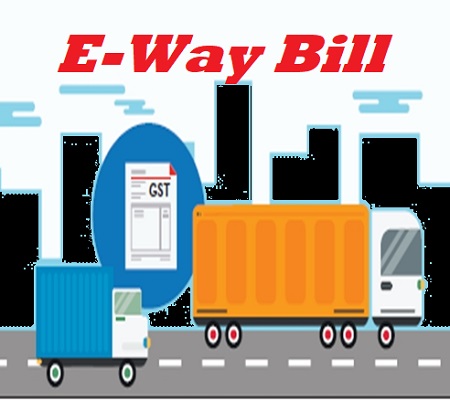E-Way Bill: With GST taking move in the country, E Way Bill is also on its way now. E-way Bill is an electronic document which the taxpayers would need to move their goods freely throughout the country. It can be easily generated on the e-way Bill Portal.
What is an eWay Bill?
E-way bill or Electronic-way bill may be a document introduced under the GST regime it’s for movement of products to be generated on the eWay Bill Portal. A GST registered person cannot transport goods during a vehicle whose value exceeds Rs. 50,000 (Single Invoice/bill/delivery challan) without an e-way bill that’s generated on ewaybillgst.gov.in.
Alternatively, Eway bill also can be generated or cancelled through SMS, Android App and by site-to-site integration through API.
The e-way bill was unrolled nationwide on 1st April 2018.
When Should eWay Bill be issued?
The E-Way Bill must be generated before the commencement of movement of products . it’s issued for any consignment value exceeding INR 50,000
eWay Bills must be generated on the common portal for of these sorts of movements. surely specified Goods, the eway bill must be generated mandatorily albeit the worth of the consignment of products is a smaller amount than Rs. 50,000:
Inter-State movement of products by the Principal to the Job-worker by Principal/ registered Job-worker**,
Inter-State Transport of Handicraft goods by a dealer exempted from GST registration.
The facility of generation and cancellation of E-Way Bill are going to be made available through SMS. Cancellation of E-Way Bill
Where an e-way bill has been generated under this rule, but goods are either transported or aren’t transported as per the small print furnished within the e-way bill, the e-way bill could also be cancelled electronically on the common port,
Use of e-Way Bill
- Registered GST Taxpayers can register within the e-Way Bill Portal using GSTIN.
2.Unregistered Persons/ Transporters can enroll within the e-Way Bill System by providing their PAN and Aadhaar.
3. Supplier/ Recipient/ Transporter can generate the e-Way Bill.
4.Vehicle number are often entered/updated partially – B of Form EWB – 01 by those that have generated the e-Way Bill or by the Transporter.
5.QR code is provided within the e-Way Bill to facilitate quick verification.
Certain goods are exempted from e-Way Bill and therefore the list is out there as Annexure to Rule 138 of CGST Rules. e-Way Bill isn’t required.
Section 68 of the Act mandates that the govt may require the person responsible of a conveyance carrying any consignment of products useful exceeding such amount as could also be specified to hold with him such documents and such devices as could also be prescribed. Rule 138 of CGST Rules, 2017 prescribes e-way bill because the document to be carried for the consignment of products in certain prescribed cases. Hence e-way bill generated from the common portal is required.
Read More: Best Courses to Learn in Covid19 Lockdow
Contents of e-Way Bill
GSTIN of Recipient: Mention the GSTIN number of the recipient.
Place of Delivery: Here you want to mention the Pin Code of the place where goods are delivered.
Invoice or Challan Number: Mention the Invoice or Challan number against which the products are supplied.
Value of Goods: Mention the consignment value of products .
HSN Code:Enter the HSN code of products which are transported. If your turnover is up to INR 5 crores, you would like to say the primary 2 digits of HSN code. If it’s quite INR 5 crores, 4 digits of HSN code are required.
Reason for Transportation: the rationale for transportation is pre-defined and you would like to pick the foremost appropriate option from the list.
Transport Document Number: this means either one among the products Receipt Number, Railway Receipt Number, Airway Bill Number or Bill of Lading Number.
Modes Of EWay Bill
Using Web based system
Using Android App
Bulk generation facility
Using Site-to-Site integration
Steps to get E-Way Bill Login
Step 1: Login to E-Way Bill Portal at https://ewaybill.nic.in/ together with your login details.
Note: To get E way Bill or e-way bill login, it’s mandatory to possess GST Registration and transporter registration.
Step 2: Pick the “Generate New” option from the left menu.
Step 3: Fill within the details
If you’re a supplier, select “Outward” because the transaction type.
If you’re the receiver, select “Inward” and enter details of the supplier and recipient along side GSTIN, wherever applicable. a number of the fields are going to be auto-populated when GSTIN is provided.
STEP 4: Enter Goods Description
Product Name and outline must be completed even as you are doing in your tax invoice.
HSN Code for the merchandise must be entered. Click here to seek out HSN code.
Enter the IGST or CGST Rates applicable. IGST would be applicable for inter-state transport and SGST / CGST for intra-state transport.
The approximate distance of transport. this is able to determine the validity of the eway bill.
Step 5: Click on Submit
Click on the “SUBMIT” button to get your E way bill. Now, the eWay bill will appear which contains the E way bill number and therefore the QR Code that contains all the small print . Print the copy of the bill and supply it to the transporter who will carry it throughout the trip till it’s being handed over to the receiver.
One of the most objectives of the e-way bill provision is to curb revenue leakage. Hence, within the near future, businesses are often expected to receive notices/queries seeking explanations for discrepancies within the data reported within the GST returns vis-à-vis the e-way bill portal.
The validity of e-way bill depends on the space to be travelled by the products . For a distance of but 100 Km the e-way bill are going to be valid for each day from the relevant date. for each 100 Km thereafter, the validity are going to be additional at some point from the relevant date.
frequently asked questions (FAQs)
Ans.- E-way Bill is an electronic document which the taxpayers would need to move their goods freely throughout the country
Ans.- Step 1: Login to E-Way Bill Portal at https://ewaybill.nic.in/ together with your login details.
Step 2: Pick the “Generate New” option from the left menu.
Step 3: Enter Goods Description and then click on submit button.
Ans.- It is mandatory to generate E–Way Bill from 1st April 2018 for transportation of goods from one state to other.
Ans.- Usually, the seller is responsible for e–way bill generation.
Ans.- One does not require to Generate e–way bill when goods being transported are exempted as per the State or Union Territory GST Rules.








